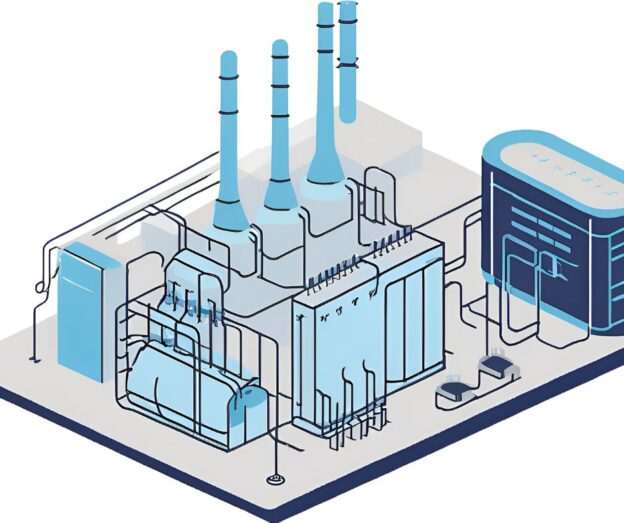The HVAC system in a commercial building represents 45% or more of the annual energy expenditure. It is crucial to address inefficiencies and ensure the system’s long-term functionality. Suboptimal HVAC system performance can be attributed to various factors such as design, procurement, installation, operation, and maintenance. A comprehensive approach to resolving these issues can result in enhanced efficiency and prolonged equipment lifespan. This article will delve into the common issue of “Low Delta T syndrome” within HVAC systems, specifically in Primary/Secondary or Variable Primary Flow chilled water piping configurations. Facility Management Teams frequently encounter this problem and can have a significant impact on system performance.
A low Delta T indicates deteriorated performance of the Central Air Conditioning system of constant primary and variable secondary chilled water
When the difference between the chilled water temperature leaving the system and entering it is lower than the optimal design temperature, it leads to a condition called ‘Low Delta T’ syndrome in the District Cooling system. In a central cooling system consisting of Electric Chillers and Thermal storage, the delta T is designed to be around 12°C.
ASHRAE Green guide prescribes
- 12 to 20°F (7°C to 11°C) ΔT chilled water
- 12 to 18°F (7°C to 10°C) ΔT condenser water.
However, most of the year, the chiller system operates at a partial load, causing the temperature to drop below the intended threshold. District Cooling Service contracts often include penalty clauses for failure to maintain the DT at the premises above the prescribed threshold.
Effect of Low DT syndrome
- The operating capacity of the Chillers is limited by the ratio of the actual temperature difference (Delta T) to the design temperature difference (Delta T). For example, if the actual Delta T (DT) is 5 °C and the design Delta T (DT) is 9 °C, the maximum operating capacity is limited to 56% of the rated maximum capacity (5/9 = 56%).
- To compensate for the increased cooling demand, the overworked chilled water pumping system doubles the required chilled water, leading to substantial energy expenditure due to diminished operating capacity.
- According to the Affinity Law, the power utilized is proportional to the cube of water flow. Per degree Celsius rise in room temperature can result in an average of 3-6% energy savings.
- Controlling units operate out of the design framework leading to ununiform cooling
- Local thermal discomfort to occupants.
Causes of Low Delta T syndrome in a variable-air volume designed cooling system

Design detailing
- Improper installation of Secondary pump differential pressure sensors
- Improper calibration of sensors and controllers
- Usage of three-way valves
- Improper selection of cooling (coil DT lower than the plant design DT)
- Improper selection of Control Valves (over-sized valves, under-sized actuators)
- Inadequate or missing interlocking between chilled water shut-off valves and the associated Air Handling Units.
- The supply water temperature controller in the return line is set close to the design chilled water temperature.
- Uncontrolled process loads (controlling chilled water matching the design requirements of the process).
- Outdoor Air Economizers contribute to Low DT
Commissioning
- Poor water balancing
- Poor calibration and on-site testing of controls and meters
- Inadequate digital metering system
- Inadequate information sharing with the Maintenance team
- Inadequate knowledge and training for the commissioning team
- Poor Operations and Maintenance program
Procurement
- Inadequate critical spares’ stock management. Defective or missing spares are not procured for replacement.
- Inadequate or wrong specifications used in procurement detailing of
- Old worn-out pumping system
- Flow control devices
- Instrumentation and control
- Meters – Temperature, Pressure, Humidity
- controllers, actuators, valves
Operations and Maintenance
- Rebalancing chilled water flow to match design specifications
- Off-peak business hours and vacant floors throughout most of the year require part-load operation of chiller plants.
- Inadequate secondary pumping and ventilation system controls responding to variable demand load.
- Malfunction of Terminal Cooling Units
- Malfunctioning instruments requiring cleaning, calibration, replacements
- Actuators not closing off due to undersize capacity, accumulated dirt, etc
- Control valves not shutting off in sync with the Air Handling Units
- Fouled coils requiring cleaning of fins
- Dirty Filters requiring cleaning
- Clogged strainers requiring regular cleaning
- Bypassing air around coils
- Uncontrolled process loads
Technology trends towards more efficient HVAC system
- Adaptive Frequency Drives
- Compressors, Pumps (Primary and Secondary), Fans
- Supervisory controls and smart metering
- Controls
- Open protocol
- Easy networking interoperable connectivity
- Troubleshooting diagnostics
- Data analytics-driven control and command
- Retrofit solutions
- Pressure independent Flow Control Valves to replace two-way valves at AHUs, PAHUs, FCUs
- Reposition and recalibrate differential pressure sensors and set points to adequately respond to seasonal and operational variations.
Conclusion:
The occurrence of ‘Low Delta T’ syndrome is not uncommon in large commercial properties. To address this issue, the Facilities Management team must recognize the gaps between system design and operational parameters. It is crucial to conduct a technical assessment of the system and create a roadmap to enhance system efficiency comprehensively. This technical and commercial assessment should be complemented by an analysis of building occupants’ satisfaction surveys to ensure a well-rounded approach to the problem.


Generally during summer delta T will maintain nearly as per design and during winter delta T may be reduced due to improper plant operations. sometimes no need for a chiller online and only chilled water circulation will be sufficient to achieve design delta T. In my experience during commissioning header chilled water, hook-up lines were not flushed thoroughly so a lot more dirt and sand particles entered the in chilled water loop affecting the delta T as 3.5 to 5 Deg.C instead of the design delta T was 10.4 Deg.C. Hence, all AHUs and FCUs strainers needed to clean and flush the chilled water line to improve the delta T